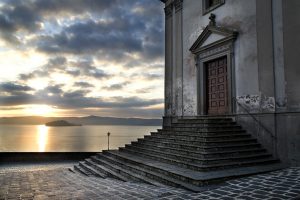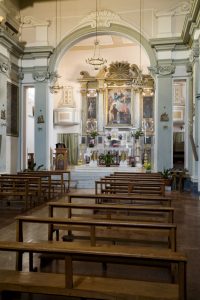- admin
- Nov, 09, 2024
- Places to visit
- Commenti disabilitati su 4. Church of Santa Maria Assunta


Admiring this church, built in a charming location with a wide view of the lake, it is hard to imagine that it was originally much smaller than it is today and was part of the courtyard that enclosed the space in front of the Rocca. It was designed to protect the first cluster of castle houses. The expansion work began before the construction of the Rocca itself, under Ranuccio III in 1440, and continued in phases until the second half of the 16th century, under Cardinal Alessandro, who would later become Pope Paul III.
The first historical document mentioning this church dates back to 1453, when Capodimonte had about fifty families, totaling around 200 inhabitants, and the parish of Santa Maria Assunta (as it was then called) had a curate, referred to at that time as “Rettore.” At that time, there was neither the large central arch inside nor a ceiling; it was likely covered by a roof supported by wooden trusses and was much smaller in size.
The extension of the Church of Santa Maria del Castello was carried out under Cardinal Alessandro, who commissioned the project from the great architect Jacopo Barozzi, known as il Vignola, during the time he was working on the design of the grand church of SS. Giacomo e Cristoforo on Bisentina Island. However, Vignola, engaged in much more ambitious projects such as the Palazzo di Caprarola and the Church of Gesù in Rome, neglected the expansion of the church in Capodimonte. In a letter sent to the cardinal in 1562, he apologized for having only sketched an incomplete design: “The drawing of the church of Capodimonte is not done in good form enough to be useful, for I made a simple sketch.”
Despite this, the church was completed following the architecture suggested by Vignola, with a partial demolition of the back wall transformed into a large semicircular arch and with the extension of the building that incorporated the parish house to create the presbytery. This extension of about ten meters allowed for the definition of a large central nave space, as we see it today, adorned with stucco decorations and enriched by six altars—three on each wall—giving the complex an elegant simplicity.
Subsequent additions included the bell tower, which was initially a simple structure with two bells and was transformed into a tower with a square spire and three bells only in the 18th century. The external staircase was built by Pope Benedict XV in 1917.
The transformation from a simple parish church to a “Collegiata” occurred in 1775 under Cardinal Francesco Maria Banditi, with the consent of Pope Pius VI, during the pastorate of Alessandro Maria Macchi.
This period also saw the construction of the sacristy in 1777, adorned with an 18th-century wooden wall and featuring an altar dedicated to the Most Sacred Heart of Jesus at its center. On the tympanum of the external portal, the Farnese lily is visible in stone.
Today, on the grand panoramic staircase, numerous couples capture their wedding day in beautiful photographs, and several film scenes have been shot here due to the spectacular landscape.
Entering through the main entrance and moving counterclockwise inside the church, we can admire on the first altar at the back right, near the Baptismal Font, a wooden crucifix from the Roman school of the 15th-16th century. This was donated in 1694 by Cardinal Marco Antonio Barbarigo, Bishop of Montefiascone, to the first girls’ school in Capodimonte run by the Maestre Pie Filippini sisters.
On the second altar, there is a beautiful wooden statue of the Sacred Heart of Jesus, dated 1927, with the inscription “I SOLDATI ANNO 1942.” Above the side entrance door, a canvas depicts Saint Charles Borromeo. Still on the right side, a marble plaque commemorates the death of Marco Poccia, a nobleman from Tuscania. The third altar is dedicated to Saint Joseph on his deathbed and to Our Lady of Sorrows (18th century), attributed to the Viterbo painter Domenico Corvi.
On the main altar, there is a valuable painting depicting the Assumption of the Blessed Virgin Mary, attributed to the school of Tiepolo, characteristic of Venetian art from the late 17th century. The Virgin, dressed in her customary red dress and blue mantle, is carried to heaven by a cloud, surrounded by a host of angels, while at her feet are the apostles Peter, Paul, John, and Andrew gathered around an empty sarcophagus.
On either side of the main altar, two altarpieces depict Saint Sebastian, the protector of the town, and Saint Bernardino of Siena. Beneath them are representations of the martyrs Agapito and Eurosia, co-patrons of the town.
Behind the large canvas of the Assumption on the main altar is hidden in a niche a large wooden statue of the Assumed Virgin Mary from the 19th century, of Neapolitan school origin. This statue was traditionally carried in procession on the evening of August 14th, the eve of the Assumption feast.
Today, for this celebration, it is preferred to transport a lighter statue dating back to the 17th century and kept in the sacristy. This statue depicts the Madonna Assunta in Cielo above a cloud carried by cherubs, dressed in red with a blue mantle sprinkled with stars. The drapery suggests movement as she ascends.
On the lateral walls of the main altar, we can admire two large 17th-century stucco coats of arms, painted in color. The one on the right features the well-known red cardinal’s hat and the characteristic six blue lilies on a golden background, a clear reference to Cardinal Alessandro Farnese “il Giovane.” The one on the left displays the coat of arms of the Farnese family, featuring a red background with a papal umbrella surmounting two crossed keys and six lilies on the side quadrants.
Continuing along the left side, we find the first altar, which houses a reproduction of the painting of the Blessed Virgin Mary of Grace. The original, kept in a secure location, is attributed to the school of Neapolitan painter Sebastiano Conca (1680-1764), who likely collaborated on its execution, particularly in depicting the Child lovingly looking at His Mother. The inhabitants of Capodimonte are particularly devoted to Our Lady of Grace and commemorate the day when this precious canvas was brought to Capodimonte through the tradition of Infiorata (described later).
The second altar features an image of Saint Philip Neri (17th century), while the last altar at the back holds a valuable canvas of Our Lady of Mount Carmel with prophets Elijah and Elisha, dating back to 1620 and attributed to painter Baglione.
Below the church lies a chapel dedicated to Our Lady of Loreto, adorned with stucco decorations (16th century) and frescoes depicting Saint Bernardino of Siena and other saints. On the ceiling, an 18th-century fresco portrays God the Father blessing. The crypt can be accessed through a door located on the left outer wall of the church.